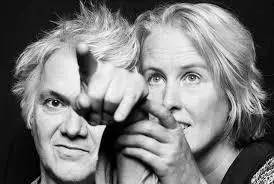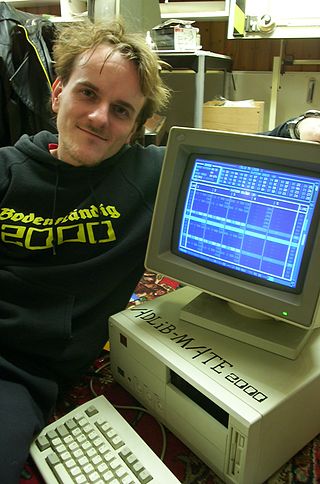Related Research Articles

Colleen Doran is an American writer-artist and cartoonist. She illustrated hundreds of comics, graphic novels, books and magazines, including the autobiographical graphic novel of Marvel Comics editor and writer Stan Lee entitled Amazing Fantastic Incredible Stan Lee, which became a New York Times bestseller. She adapted and did the art for the short story "Troll Bridge" by Neil Gaiman, which also became a New York Times bestseller. Her books have received Eisner, Harvey, Bram Stoker, Locus, and International Horror Guild Awards.

Linda Jean Barry, known professionally as Lynda Barry, is an American cartoonist. Barry is best known for her weekly comic strip Ernie Pook's Comeek. She garnered attention with her 1988 illustrated novel The Good Times are Killing Me, about an interracial friendship between two young girls, which was adapted into a play. Her second illustrated novel, Cruddy, first appeared in 1999. Three years later she published One! Hundred! Demons!, a graphic novel she terms "autobifictionalography". What It Is (2008) is a graphic novel that is part memoir, part collage and part workbook, in which Barry instructs her readers in methods to open up their own creativity; it won the comics industry's 2009 Eisner Award for Best Reality-Based Work.
Hypertext fiction is a genre of electronic literature, characterized by the use of hypertext links that provide a new context for non-linearity in literature and reader interaction. The reader typically chooses links to move from one node of text to the next, and in this fashion arranges a story from a deeper pool of potential stories. Its spirit can also be seen in interactive fiction.

Jodi, is a collective of two internet artists, Joan Heemskerk and Dirk Paesmans, created in 1994. They were some of the first artists to create Web art and later started to create software art and artistic computer game modification. Their most well-known art piece is their website wwwwwwwww.jodi.org, which is a landscape of intricate designs made in basic HTML. JODI is represented by Upstream Gallery, Amsterdam.
net.art refers to a group of artists who have worked in the medium of Internet art since 1994. Some of the early adopters and main members of this movement include Vuk Ćosić, Jodi.org, Alexei Shulgin, Olia Lialina, Heath Bunting, Daniel García Andújar, and Rachel Baker. Although this group was formed as a parody of avant garde movements by writers such as Tilman Baumgärtel, Josephine Bosma, Hans Dieter Huber and Pit Schultz, their individual works have little in common.

Cory Arcangel is an American post-conceptual artist who makes work in many different media, including drawing, music, video, performance art, and video game modifications, for which he is best known.

Interactive design is a user-oriented field of study that focuses on meaningful communication using media to create products through cyclical and collaborative processes between people and technology. Successful interactive designs have simple, clearly defined goals, a strong purpose and intuitive screen interface.

Natalie Bookchin is an artist based in Brooklyn, New York. She is well known for her work in media. She was a 2001-2002 Guggenheim Fellow. Her work is exhibited at institutions including PS1, Massachusetts Museum of Contemporary Art, the Museum of Contemporary Art in Barcelona, KunstWerke, Berlin, the Generali Foundation, Vienna, the Walker Art Center, the Whitney Museum of American Art, and the Shedhale in Zurich. Her works are in a variety of forms – from online computer games, collaborative performances and "hacktivist" interventions, to interactive websites and widely distributed texts and manifestos. In her work, she explores some of the far-reaching consequences of Internet and digital technologies on a range of spheres, including aesthetics, labor, leisure, and politics. Much of Bookchin's later works amass excerpts from video blogs or YouTube found online. From 1998 to 2000 she was a member of the collective RTMark, and was involved in the gatt.org prank they organized spoofing the 1999 General Agreement on Tariffs and Trade talks
The conservation and restoration of new media art is the study and practice of techniques for sustaining new media art created using from materials such as digital, biological, performative, and other variable media.
Cine Fantom is a film club in Russia.

Olia Lialina is an Internet artist and theorist, an experimental film and video critic and curator.

Dragan Espenschied is an 8-bit musician and media artist who lives and works in New York City. He studied communication design at the Merz Academy in Stuttgart, Germany. Dragan started to develop software for Atari Computers in 1991.
Rhizome is an American not-for-profit arts organization that supports and provides a platform for new media art.

Internet art is a form of new media art distributed via the Internet. This form of art circumvents the traditional dominance of the physical gallery and museum system. In many cases, the viewer is drawn into some kind of interaction with the work of art. Artists working in this manner are sometimes referred to as net artists.

Heath Bunting is a British contemporary artist. Based in Bristol, he is a co-founder of the website irational.org, and was one of the early practitioners in the 1990s of Net.art. Bunting's work is based on creating open and democratic systems by modifying communications technologies and social systems. His work often explores the porosity of borders, both in physical space and online. In 1997, his online work Visitors Guide to London was included in the 10th documenta curated by Swiss curator Simon Lamunière. An activist, he created a dummy site for the European Lab for Network Collision (CERN).
Angela Washko is an American new media artist and facilitator based in New York. She is currently associate professor of art at Carnegie Mellon University. Washko mobilizes communities and creates new forums for discussions of feminism where they do not exist.

Library of the Printed Web is a physical archive devoted to web-to-print artists’ books, zines and other printout matter. Founded by Paul Soulellis in 2013, the collection was acquired by The Museum of Modern Art Library in January 2017. The project has been described as "web culture articulated as printed artifact," an "archive of archives," characterized as an "accumulation of accumulations," much of it printed on demand. Techniques for appropriating web content used by artists in the collection include grabbing, hunting, scraping and performing, detailed by Soulellis in "Search, Compile, Publish," and later referenced by Alessandro Ludovico.
Blingee is an online animated GIF creator that allows users to create layered images using original photographs and artwork combined with user-generated ornamentation, referred to as "stamps."
Aria Dean is an American artist, critic, and curator. Until 2021, Dean served as Curator and Editor of Rhizome. Her writings have appeared in various art publications including Artforum, e-flux, The New Inquiry, Art in America, and Topical Cream. Dean has exhibited internationally at venues such as Foxy Production and American Medium in New York, Chateau Shatto in Los Angeles, and Arcadia Missa in London. Dean also co-directs As It Stands LA, an artists project space that opened in 2015. Dean lives and works in New York City and Los Angeles. She is represented by Greene Naftali.
RaFia Santana is a non-binary American artist, musician, and performer based in Brooklyn, NY. Her work ranges from animated gifs to self-portraiture, videos, and performance to editioned clothing and electronic music exploring gentrification, the millennial mindset, mental health, and the lived black experience. They use the internet as a medium to share their artwork, empower black and brown communities, and challenge ideas of solidarity and alliance. She had exhibitions and/or performances at the Eyebeam, AdVerse Fest, SleepCenter, Times Square Arts, International Center of Photography, Schomburg Center for Research in Black Culture, Babycastles, Museum of the Moving Image and Museum of Contemporary African Disaporan Arts, Roots & Culture amongst many notable venues. Her work has been featured in publications such as Huffington Post, HyperAllergic, Rhizome, ArtFCity, Vogue, Teen Vogue and Salon. They have participated in panels, performances and discussions such as Cultured Magazine, "Late at Tate Britain", Creative Tech Week NYC, Afrotectopia at Google NYC, NYU, "Black Portraitures IV: The Color of Silence" at Harvard University and International Center for Photography. Their music is released through Never Normal Records.
References
- ↑ "My Boyfriend Came Back From the War". Olia Lialina. Archived from the original on 30 October 2016. Retrieved 26 February 2014.
- ↑ "Mark Tribes teaching wiki: Olia Lialina". Archived from the original on 5 October 2013. Retrieved 26 February 2014.
- ↑ "Speaking in Net Language: My Boyfriend Came Back from the War". Rhizome. Archived from the original on 13 March 2017. Retrieved 12 March 2017.
- ↑ "Video Adaptation of My Boyfriend Came Back From the War". Archived from the original on 8 November 2010. Retrieved 9 April 2010.
- ↑ "Olia Lialina - 20 Years of My Boyfriend Came Back From The War | Josephine Bosma". www.josephinebosma.com. Archived from the original on 13 March 2017. Retrieved 12 March 2017.
- ↑ "University of Maryland Syllabus". Archived from the original on 7 June 2010. Retrieved 9 April 2010.
- ↑ "Emily Carr University Syllabus". Archived from the original on 25 February 2012. Retrieved 5 September 2017.
- ↑ Espenschied, Dragan; Rechert, Klaus (2016). "Exhibiting Digital Art via Emulation". phaidra.univie.ac.at. Archived from the original on 2 February 2020. Retrieved 2 February 2020.
- ↑ HeK. "HeK - My Boyfriend Came Back From The War. online since 1996". www.hek.ch. Archived from the original on 13 March 2017. Retrieved 12 March 2017.
- ↑ Himmelsbach, Sabine (2016). My boyfriend came back from the war. Stuttgart: Merzakademie. ISBN 978-3-85616-689-2.
- ↑ "MU | Olia Lialina - 20 Years Of My Boyfriend Came Back From The War". mu.nl. Archived from the original on 13 March 2017. Retrieved 12 March 2017.
- ↑ "RHIZOME NET ART ANTHOLOGY, My Boyfriend Came Back From the War". RHIZOME NET ART ANTHOLOGY, My Boyfriend Came Back From the War. 27 October 2016. Archived from the original on 12 March 2017. Retrieved 12 March 2017.